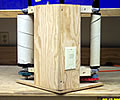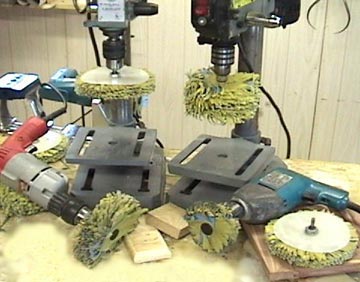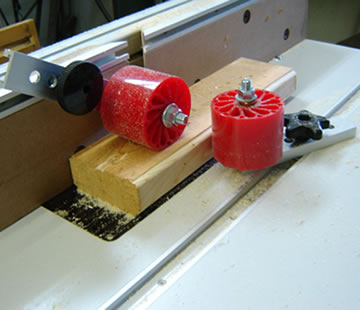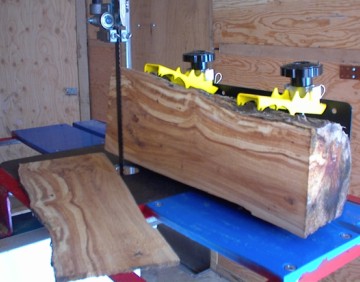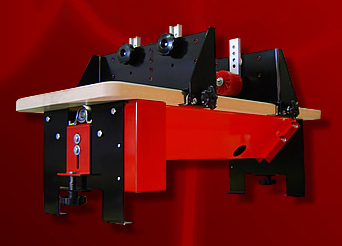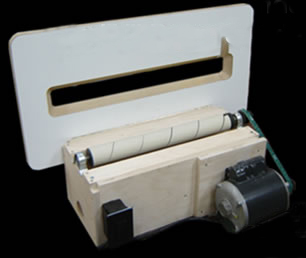
Some tool ideas arrive from out of the blue and others are designed to fill a bare market niche, but the V Drum Sander had a different origin. It came about as the result of its inventor being forced to field one too many complaints from annoyed sandpaper customers about the paper loading up on their drum sanders.
Paul Moore, its creator, is an inveterate problem solver with a long history of tool design. By combining that with some advice from a former shop teacher, Paul was able to devise an under-the-table drum sander that works entirely differently than any you’ve seen before. The result is a tool that drops its own dust out of the way, does not clog or burn sandpaper or wood, and puts almost no pressure on the wood it sands.
“I was brought up in a farming community in Ontario, Canada, where my dad was the local mechanic,” Paul recounted by way of explanation. “As a kid, I worked with him, learning to fix everything and anything. We welded, machined and cobbled all sorts of tooling. In time, I became an ironworker, welder and fitter. I managed a hardware store in a small community in the early 1980s, and later got hired as the tool manager of a large hardware store.
“By 1985, I was directly importing tools from China for Stamford Hardware, at the time the largest tool dealer in Ontario. I’m an efficiency freak, so I was always redesigning tools in my head and sharing that information with the company. Then in 1987, Black and Decker hired me as an advisor for their new tool line. That let me deal with ergonomics and how people use tools.
“My wife and I decided to start our own company in 1997 selling sandpaper, sanding belts and disks, buffing compounds and other abrasive media. We called the company Stockroom Supply, an allusion to the fact that most large companies have stockrooms workers can call for needed supplies. That same year, we introduced the sanding mop by changing an existing metalworking tool to one that used abrasives more appropriate to woodworking. Although we came up with the name, we don’t currently own it. Instead, we allowed it to become the generic term for profile sanders made of multiple fingers of flexible sanding cloth on a mandrel.
“At the time, it seemed like drum sanders were the hot new tool, and Klingspor was the media supplier for most of them. Because I was selling Klingspor sanding media, people at woodworking shows were forever harassing me about their drum sander paper loading up. I figured out that there were two reasons for the problem. First, most drum sanders had improper dust collection, and second, they tended to force the paper into the wood.
“What was needed for the first problem was a sander that sanded from the bottom up instead of the top down. That way you did not sand through your own sawdust, and gravity made the swarf fall below the sanding area. The other problem was solved by remembering advice from a shop teacher who would routinely tell me to stop pushing and let the sandpaper cut. For that, we created a sander that exerted no excessive pressure on the paper. We did that by leaving the drum below the table and having only the sandpaper itself protrude above it. With those two characteristics in place, the V Drum Sander was born.
“Essentially, the V-Drum is a surface sander. Its drum sits just slightly below a flat table with a slot in it. The drum spins fast enough so that the paper, which is held on by Velcro®, expands slightly off the drum due to centrifugal force. As a result, when the drum is turned on, the paper lifts about eighteen thousandths of an inch off the drum. That’s just enough for the paper to now be slightly proud of the top of the table. How proud depends on the size of the grit. The upshot is that you no longer sand by pressure of the drum, but rather by the size of the grit. The high speed of the rotating drum, which must be at least 2,050 rpm, is crucial to making the paper lift properly and consistently.
“While other sanders rely on pressure applied by the drum or roller to the wood, ours relies on consistent grit size across the surface. In a sense, the drum has nothing to do with the sanding process. It’s actually sandpaper floating in air relative to the outside of the drum. The hook and loop mechanism is what lets this happen.
“Since the hook and loop is the same for each paper, and each moves the same amount from the drum, the difference in sanding is controlled by the difference in the size of the abrasive. For example, 220-grit will cut two thousandths of an inch, because that is the size of the grit. Eighty-grit will cut fifteen thousandths per pass.
“Everything that comes off the flat table is perfectly flat. As a result, the tool is perfect for raised panel doors, segmented rings for bowl turners, figured wood and veneers, and most anything else. Add a fence and it becomes an abrasive jointer. Because the grit is not pushed into the wood, it does not generate heat. As a consequence, you can sand with much finer grit than you could with any type of drum sander.
“We originally called it the Velcro® Drum sander, because we use Velcro brand hook and loop fastener material on the drum. In spite of the fact that we still use their product, the company objected to the name, so we changed it to V Drum. We chose materials for the drum itself that would minimize static charge, which is what causes sawdust to cling. That allows sanding swarf to drop down below the table and off the drum, even without dust collection. However, we suggest you use dust collection anyway.
“Initially, we introduced it as a six-inch upright sander that fitted to your drill press, but customers wanted a larger drum, so we laid it down and made it 18 inches long. Soon customers starting asking for larger drums, and we added a 24-inch and a 30-inch model.
“Figuring that woodworkers could make their own cases out of wood, we sold them only the drum, bearings and link belt needed to create the tool, along with instructions on how to do it. That meant you could use a motor that you have, since it requires only a quarter horsepower motor, and you’d save both shipping and assembly by doing it yourself. That appealed to woodworkers tremendously, and it allowed us to offer the tool for only $180. The price has since risen to $225, but I still discount them at woodworking shows for $180.
“We still sell all sorts of sanding media, and we continue to add other tools that make woodworking easier and safer. One example is The Little Ripper, a holder for small diameter logs being cut on a band saw. Another is our line of feather wheels, which work like a feather board but feed more smoothly and won’t mark or crush the wood. We also sell the Flat Master, which is our drum sander kit already built for those who don’t have time to make their own. Now that we have a detail sander, the sanding mop, and a flat sander, the V Drum, our next introduction, scheduled for the fall, will be a contour sander.
“All of our products are manufactured right here in Canada, and to keep prices down, we sell only direct from our web site or at woodworking shows. In my opinion, the people who are really up to speed in their woodworking circles are the ones who take the time to go to woodworking shows and see firsthand what is new. I think that’s the best thing you can do.”
Paul even had some good advice to offer about how to deal with both show dealers and tool evaluation. “Don’t just stand there and watch someone use the tool,” he suggests. “Ask if you can try it.
“Make sure you evaluate the new products on the market and don’t just stick with the old standards. Because of new technologies, some of the newer ways of doing things are so much more efficient, and it would be a shame for you to miss out on them.”
